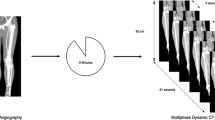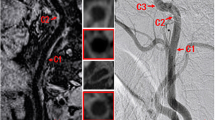Abstract
Objective
The purpose of this study is to evaluate the accuracy of semiautomated analysis of contrast enhanced magnetic resonance angiography (MRA) in patients who have undergone standard angiographic evaluation for peripheral vascular disease (PVD).
Background
Magnetic resonance angiography is an important tool for evaluating PVD. Although this technique is both safe and noninvasive, the accuracy and reproducibility of quantitative measurements of disease severity using MRA in the clinical setting have not been fully investigated.
Methods
43 lesions in 13 patients who underwent both MRA and digital subtraction angiography (DSA) of iliac and common femoral arteries within 6 months were analyzed using quantitative magnetic resonance angiography (QMRA) and quantitative vascular analysis (QVA). Analysis was repeated by a second operator and by the same operator in approximately 1 month time.
Results
QMRA underestimated percent diameter stenosis (%DS) compared to measurements made with QVA by 2.47%. Limits of agreement between the two methods were ± 9.14%. Interobserver variability in measurements of %DS were ± 12.58% for QMRA and ± 10.04% for QVA. Intraobserver variability of %DS for QMRA was ± 4.6% and for QVA was ± 8.46%.
Conclusions
QMRA displays a high level of agreement to QVA when used to determine stenosis severity in iliac and common femoral arteries. Similar levels of interobserver and intraobserver variability are present with each method. Overall, QMRA represents a useful method to quantify severity of PVD.
Similar content being viewed by others
Abbreviations
- CE-MRA:
-
Contrast enhanced magnetic resonance angiography
- QMRA:
-
Quantitative magnetic resonance angiography
- MSCT:
-
Multislice computed tomography
References
Yanagihara Y, Sugahara T, Fukunishi Y (1992) Visual interpretation compared with caliper and computerized measurements in experimental vessel stenosis. Acta Radiol 33(6):542–545
de Vries M, de Koning PJ, de Haan MW, Kessels AG, Nelemans PL et al (2005) Accuracy of semiautomated analysis of 3D contrast-enhanced magnetic resonance angiography for detection and quantification of aortoiliac stenoses. Invest Radiol 40(8):495–503
Weissman NJ, Koglin J, Cox DA, Hermiller J, O’Shaughnessy C, Mann JT et al (2005) Polymer-based paclitaxel-eluding stents reduce in-stent neointmal tissue proliferation. A serial volumetric intravascular ultrasound analysis from the TAXUS-IV trial. J Am Coll Cardiol 48(8):1201–1205
van Assen HC, Vasbinder GB, Stoel BC, Putter H, van Engelshoven JM, Reiber JH (2004) Quantitative assessment of the morphology of renal arteries from X-ray images: quantitative vascular analysis. Invest Radiol 39:365–373
Bland JM, Altman DG (1986) Statistical methods for assessing agreement between two methods of clinical measurement. Lancet 1:307–310
Cronberg CN, Sjoberg S, Albrechtsson U, Leander P, Lindh M, Norgren L et al (2004) Peripheral arterial disease. Contrast-enhanced 3D MR angiography of the lower leg and foot compared with conventional angiography. Acta Radiol 44:59–66
U-King-Im JM, Trivedi RA, Graves MJ, Higgins NJ, Cross JJ, Tom BD et al (2004) Contrast-enhanced MR angiography for carotid disease: diagnostic and potential clinical impact. Neurology 62:1282–1290
U-King-Im JM, Trivedi RA, Cross JJ, Higgins NJ, Hollingworth W, Graves M et al (2004) Measuring carotid stenosis on contrast-enhanced magnetic resonance angiography: diagnostic performance and reproducibility of 3 different methods. Stroke 35:2083–2088
Wang YI, Winchester PA, Khilnani NM, Lee HM, Watts R, Trost DW et al (2001) Contrast-enhanced peripheral MR angiography from the abdominal aorta to the pedal arteries: combined dynamic two-dimensional and bolus-chase three-dimensional acquisitions. Invest Radiol 36:170–177
Loewe C, Schoder M, Rand T, Hoffmann U, Sailer J, Kos T et al (2002) Peripheral vascular occlusive disease: evaluation with contrast-enhanced moving-bed MR angiography versus digital subtraction angiography in 106 patients. Am J Roentgenol 179:1013–1021
Lenhart M, Herold T, Volk M et al (2000) Contrast media-enhanced MR angiography of the lower extremity arteries using a dedicated peripheral vascular coil system: first clinical results. Rofo Fortschr Geb Rontgenstr Neuen Bildgeb Verfahr 172:992–999
van den Berg JC, Moll FL (2003) Three-dimensional rotational angiography in peripheral endovascular interventions. J Endovasc Ther 10(3):595–600
Kock MC, Adriaensen ME, Pattynama PM, van Sambeek MR, van Urk H, Stijnen T et al (2005) DSA versus multi-detector row CT angiography in peripheral arterial disease: randomized controlled trial. Radiology 237:727–737
Nelemans PJ, Leiner T, de Vet HC et al (2000) Peripheral arterial disease: meta-analysis of the diagnostic performance of MR angiography. Radiology 217:105–114
Corti R, Fuster V, Fayad ZA, Worthley SG, Helft G, Smith D et al (2002) Lipid lowering by simvastatin induces regression of human atherosclerotic lesions: two years’ follow-up by high-resolution noninvasive magnitic resonance imaging. Circulation 106:2884–2887
Libby P (2002) Inflammation in atherosclerosis. Nature 420(19):868–874
Author information
Authors and Affiliations
Corresponding author
Rights and permissions
About this article
Cite this article
Pavlovic, C., Futamatsu, H., Angiolillo, D.J. et al. Quantitative contrast enhanced magnetic resonance imaging for the evaluation of peripheral arterial disease: a comparative study versus standard digital angiography. Int J Cardiovasc Imaging 23, 225–232 (2007). https://doi.org/10.1007/s10554-006-9133-4
Received:
Accepted:
Published:
Issue Date:
DOI: https://doi.org/10.1007/s10554-006-9133-4




